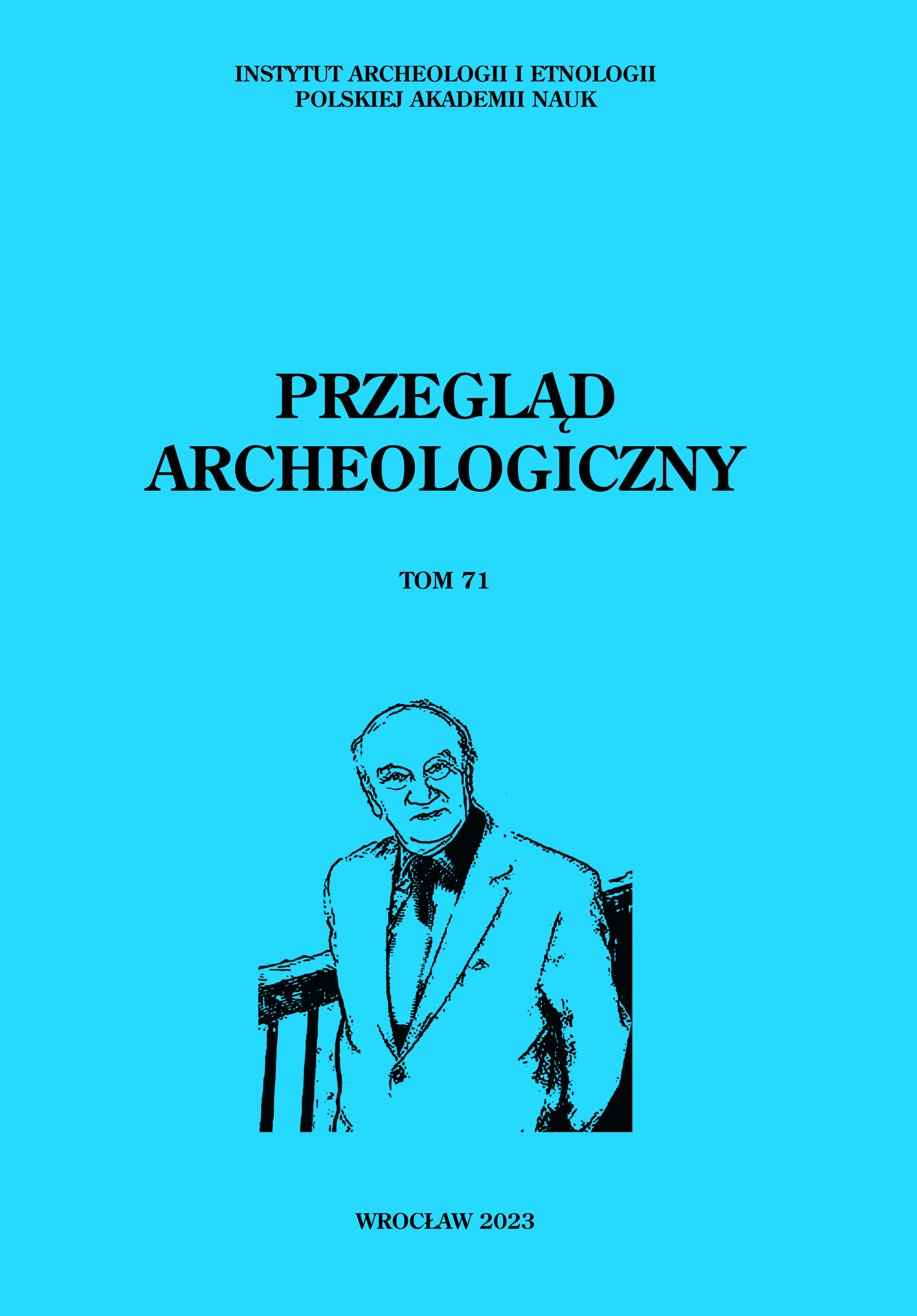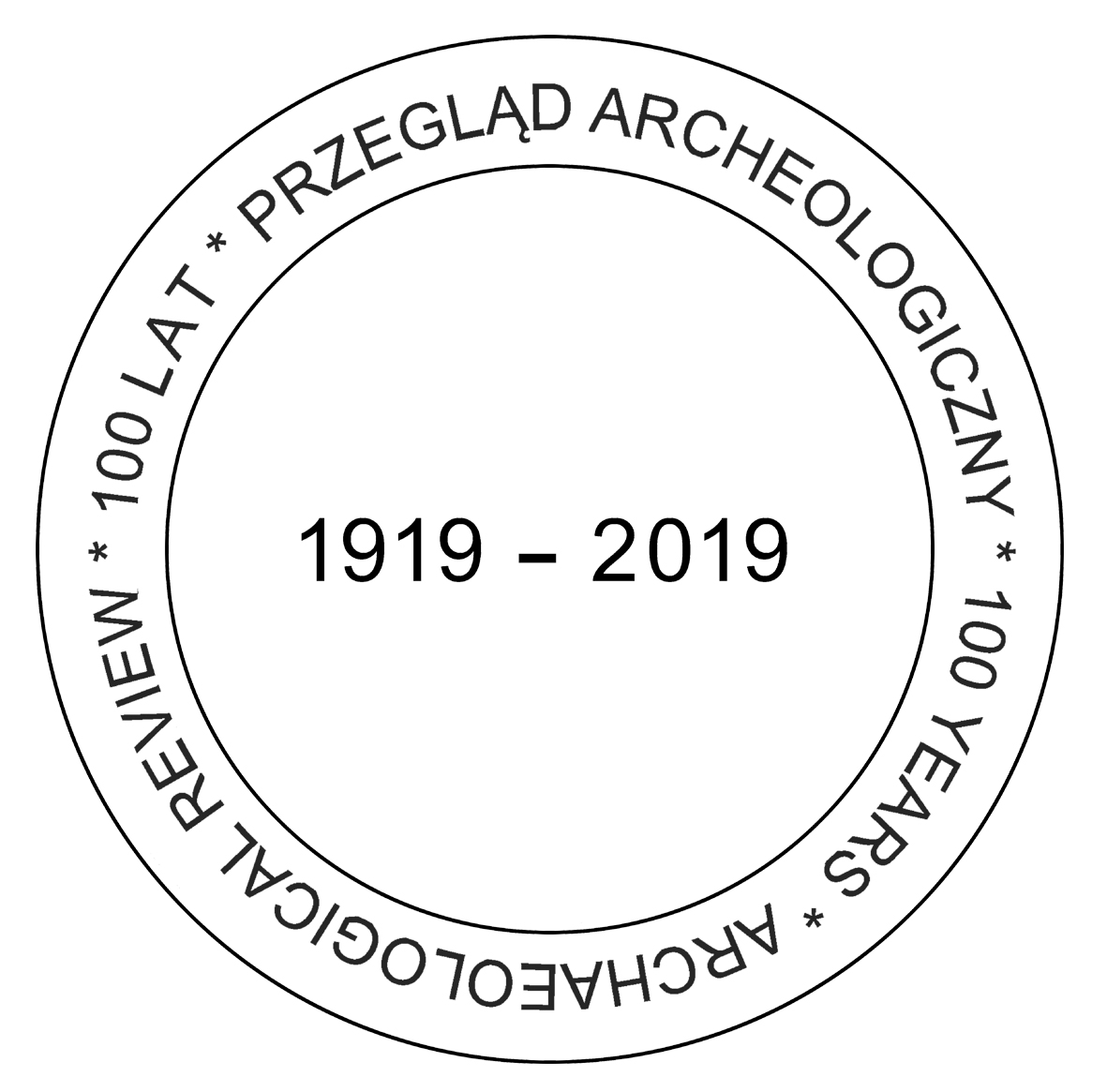The beginnings of pottery technology in Vietnam based on finds from the Xom Trai Cave in the Hoà Bình Province
DOI:
https://doi.org/10.23858/PA71.2023.2872Słowa kluczowe:
Hoabinhian culture, foragers, ceramic technology,, skeuomorphismAbstrakt
In the caves of South East Asia, artefacts from the Pleistocene period known as the Hoabinhian culture are found. They also include the oldest evidence of using pottery technology in this region. The adoption of the new technology can be seen as a deeper specialization within the hunter-gatherer economy. The use of pottery facilitates and accelerates the thermal processing of food (i.e., cooking or possibly roasting). In addition, some foods require prolonged or repeated cooking; otherwise, they may be toxic or difficult to digest. The article analyzes vessels fragments from the XomTrai Cave and additionally from the Hiem Cave – both in Hoà Bình Province in Vietnam. Based on physical characteristics, four formal and technological groups were distinguished, corresponding to three phases of use. The first is related to the decline of the Hoabinhian communities – the so-called Dabutian (the Da But culture), the second with the early Neolithic Phung Nguyen culture (or horizon), and the third with the early Bronze Age Go Mun culture.
Pobrania
Bibliografia
Adovasio J.M., Soffer O., Klíma B. (1996). Upper Palaeolithic fibre technology: interlaced woven finds from Pavlov I, Czech Republic, c. 26 000 years ago. Antiquity, 70(269), 526-534. DOI: https://doi.org/10.1017/S0003598X0008368X
Adovasio J.M., Soffer O., Hyland D.C., Klíma B., Svoboda J. (1999). Textiles, basketry and nets in the younger Paleolithic of Moravia. Archeologické Rozhledy, 51, 58-94. (In Czech).
Arnheim R. (2013). Visual thinking. Gdańsk: Słowo Obraz Terytoria. (in Polish).
Aura Tortosa E.J., Perez-Jorda G., Carrión Marco Y., Seguí Seguí J.R., Jordá Pardo J.F., Miret i Estruch C., Verdasco Cebrián C.C. (2019). Cordage, basketry and containers at the Pleistocene-Holocene boundary in southwest Europe. Evidence from Coves de Santa Maira (Valencian region, Spain). Vegetation History and Archaeobotany, 29, 581-594. DOI: https://doi.org/10.1007/s00334-019-00758-x
Boaretto E., Wu X., Yuan J., Bar-Yosef O., Chu V., Pan Y. (2009). Radiocarbon dating of charcoal and bone collagen associated with early pottery at Yuchanyan Cave, Hunan Province, China. Proceedings of the National Academy of Sciences, 106(24), 9595-9600. DOI: https://doi.org/10.1073/pnas.0900539106
Boas F. (2010). The mind of primitive man. Kraków: Momos. (In Polish).
Bobrinsky A.A. (1978). Eastern Europe pottery. Moskva: Nauka. (In Russian).
Brandt J.H. (1961). The Negrito of peninsular Thailand. Journal of the Siam Society, 49(2), 123-160.
Brandt J.H. (1965). The Southeast Asian Negrito. Journal of the Siam Society, 53, 27-43.
Brown J.A. (1989). The beginnings of pottery as an economic process. In: S. Van der Leeuw, R. Torrence (eds.), What’s new? A closer look at the process of innovation (203-224). London: Unwin Hyman.
Chung T.N. (2011). Cultural relationship between Northern Viet Nam and South China after Hoa Binh-Bac Son period. Vietnam Archaeology, 6, 31-43.
Cohen D.J. (2013). The Advent and Spread of Early Pottery in East Asia: New Dates and New Considerations for the World’s Earliest Ceramic Vessels. Journal of Austronesian Studies, 4(2), 5-92.
Cohen D.J., Bar-Yosef O., Wu X., Patania I., Goldberg P. (2017). The emergence of pottery in China: Recent dating of two early pottery cave sites in South China. Quaternary International, 441, 36-48. DOI: https://doi.org/10.1016/j.quaint.2016.08.024
Gibbs K., Jordan P. (2013). Bridging the Boreal Forest. Siberian Archaeology and the Emergence of Pottery among Prehistoric Hunter-Gatherers of Northern Eurasia. Sibirica, 12/1, 1-38. DOI: https://doi.org/10.3167/sib.2013.120101
Colani M. (1927). L’âge de la pierre dans la province de Hoa-Binh, Tonkin. Mémoire du Service géologique de l’Indochine, 14, 1-60. (In Franch).
Forestier H., Sophady H., Puaud S., Celiberti V., Frère S., Zeitoun V., Mourer-Chauviré, Mourer C.R., Than H., Billault L. (2015). The Hoabinhian from Laang Spean Cave in its stratigraphic, chronological, typo-technological and environmental context (Cambodia, Battambang province). Journal of Archaeological Science: Reports, 3, 194-206. DOI: https://doi.org/10.1016/j.jasrep.2015.06.008
Gomes A.G. (1982). Ecological Adaptation And Population Change: Semang Foragers and Temuan Horticulturalists in West Malaysia. Hawaii, East-West Environment and Policy Institute Research Report 12, Honolulu.
Goody J. (1988). The domestication of the savage mind. Cambridge: Cambridge University Press.
Gorman C.F. (1970). Excavations at the Spirit Cave, north Thailand: Some interim interpretations. Asian Perspectives, 13, 79-107.
Gorman C.F. (1971). The Hoabinhian and after: subsistence patterns in Southeast Asia during the Late Pleistocene and early recent periods. World Archaeology, 2, 300-320. DOI: https://doi.org/10.1080/00438243.1971.9979482
Gralak T. (2015). The structure and style – a cultural border in central Poland in period II of the Bronze Age. In: P. Suchowska-Ducke, S. Scott Reiter , H. Vandkilde (eds.), Forging Identities. The Mobility of Culture in Bronze Age Europe. BAR International Series 2772, 193-200. Oxford.
Gralak T. (2018a). Skeuomorphism – one of the keys to understanding prehistoric art. In: B. Gediga, A. Grossman, W. Piotrowski (eds.), Inspirations and functions of prehistoric and early medieval art (61-98). Biskupin-Wrocław. (In Polish).
Gralak T. (2018b). From triangular to curvilinear motifs, i.e., about the genesis of Scythian art. In: D. Minta-Tworzowska (ed.), Aesthetics in archeology. Imaging in prehistory and antiquity (191-225). Gdańsk: Wydawnictwo Polskiej Akademii Nauk – Muzeum Archeologiczne w Gdańsku. (In Polish).
Ha V.P. (1993). Stages of development of Go Mun culture. Khao Co Hoc, 86, 16-27.
Ha V.T. (1984-1985). Prehistoric Pottery in Viet Nam And its Relationships with Southeast Asia. Asian Perspectives, 36(1), 135-146.
Harry K.G., Frink L., O’Toole B., Charest A. (2009). How to Make an Unfired Clay Cooking Pot: Understanding the Technological Choices Made by Arctic Potters. Journal of Archaeological Method and Theory, 16, 33-50. DOI: https://doi.org/10.1007/s10816-009-9061-4
Higham C. (1996). The Bronze Age of Southeast Asia. Cambridge: Cambridge University Press.
Higham C. (2013). Hunter-gatherers in Southeast Asia: From prehistory to the present. Human Biology, 85, 21-44. DOI: https://doi.org/10.3378/027.085.0302
Hommel P. (2009). Hunter-Gatherer Pottery: An Emerging 14C Chronology. In: P. Jordan, M. Zvelebil (eds.), Ceramics before Farming: The Dispersal of Pottery among Prehistoric Eurasian Hunter-Gatherers (561-569). Walnut Creek, CA: Left Coast Press Inc.
Hommel P. (2013). Hunter-Gatherer Innovations: Ceramic Technology. In: V. Cummings, P. Jordan, M. Zvelebil (eds.), Oxford Handbook of the Archaeology and Anthropology of Hunter Gatherers. Oxford. https://core.ac.uk/download/pdf/323057756.pdf
Hommel P. (2017). What’s the point? Globalization and the Emergence of Ceramic-using Hunter-gatherers in Northern Eurasia? In: N. Boivin, M. Frachetti (eds.), Globalisation and the People without History (1-29). Cambridge: Cambridge University Press.
Hongo H., Auetrakulvit P. (2011). Ethnoarchaeology of the Mani (Orang Asli) of Trang province, Southern Thailand. A preliminary result of faunal analysis at Sakai cave. In: U. Albarella, A. Trentacoste (eds.), Ethnozooarchaeology: The Present and Past of Human-Animal Relationships (82-92). Oxford: Oxbow Books. DOI: https://doi.org/10.2307/j.ctvh1dwvg.14
Ji X., Kuman K., Clarke R.J., Forestier H., Li Y., Ma J., Qiu K., Li H., Wu Y. (2016). The oldest Hoabinhian technocomplex in Asia (43.5 ka) at Xiaodong rockshelter, Yunnan Province, southwest China. Quaternary International, 400, 166-174. DOI: https://doi.org/10.1016/j.quaint.2015.09.080
Jordan P., Zvelebil M. (2009). Ex Oriente Lux: The Prehistory of Hunter Gatherer Ceramic Dispersals. In: P. Jordan, M. Zvelebil (eds.), Ceramics Before Farming: The Dispersal of Pottery Among Prehistoric Eurasian Hunter-Gatherers (33-90). Walnut Creek, CA: Left Coast Press Inc.
Kowalski A.P. (2014). Anthropology of ancient meanings. Toruń: Polskie Towarzystwo Historyczne. (In Polish).
Králík M.M., Svoboda J., Škrdla P., Nývltová Fišáková M. (2008). New finds of ceramic fragments and imprints in the Gravettien of South Moravia. Přehled výzkumů, 49, 3-22. (In Czech).
Kuczyńska-Zonik A. (2014). Gravettian Ceramic Firing Techniques in Central and Eastern Europe. Analecta Archaeologica Ressoviensia, 9, 79-94.
Kuzmin Y.V. (2015). The origins of pottery in East Asia: updated analysis (the 2015 state-of-the-art). Documenta Praehistorica, 42, 1-11. DOI: https://doi.org/10.4312/dp.42.1
Kuzmin Y.V. (2017). The origins of pottery in East Asia and neighboring regions: An analysis based on radiocarbon data. Quaternary International, 441, 29-35. DOI: https://doi.org/10.1016/j.quaint.2016.10.011
Lee Whorf B. (2002). Language, Thought, and Reality. Warszawa: KR. (In Polish).
Lévi-Strauss C. (2001). The Savage Mind. Warszawa: KR. (In Polish).
Lévy-Bruhl L. (1992). How Natives Think. Warszawa: PWN. (In Polish).
Lim T.S. (2018). Southeast Asian Ceramics. In: C. Smith (ed.), Encyclopedia of Global Archaeology (1-16). Living Edition. London: Springer. DOI: https://doi.org/10.1007/978-3-319-51726-1_3149-1
Mallory J.P., Mair V.H. (2008). The Tarim Mummies. Ancient China and the Mystery of the Earliest Peoples from the West. London: Thames & Hudson.
Mansuy H., Colani M. (1925). Lower Neolithic (Bacsonian) and Upper Neolithic in Upper Tonkin (latest research). With the description of the skulls of the Lang Cuom deposit. Mémoires du Service géologique de l’Indochine, 12, 1-44. (In French).
McColl H. et al. (2018). The prehistoric peopling of Southeast Asia. Science, 361, 88-92. DOI: 10.1126/science.aat3628 DOI: https://doi.org/10.1126/science.aat3628
Moser J. (2001). Hoabinhian. Geographie und Chronologie eines steinzeitlichen Technokomplex in Südostasien. Köln: Lindensoft. (In German).
Nelson K. (2010). Environment, cooking strategies and containers. Journal of Anthropological Archaeology, 29, 238-247. DOI: https://doi.org/10.1016/j.jaa.2010.02.004
Nguyen G.D. (2011). Patterns of exploitative economy and settlement of neolithic inhabitants in Northern Viet Nam. Vietnam Archaeology, 6, 17-30.
Nguyen K.S. (2009). Con Moong Cave – data from exploration and new perception. Vietnam Archaeology, 4, 40-52.
Nguyen V. (2004). The Hoabinian Strategy of Food Exploitation on the Basis of a Common Broad-Spectrum Food Exploitation (Hunting, Fishing and Collecting). In: V. Paz (ed.), Southeast Asian Archaeology (454-462). Wilhelm G. Solheim II Festschrift. Quezon City: University of the Philippines Press.
Nguyen V. (2005). The Da But culture; evidence for cultural development in Vietnam during the middle Holocene. Indo-Pacific Prehistory Association Bulletin, 25, (Taipei Papers Volume 3), 89-93.
Nguyen V. (2010). Hanoi in the Pre-Thang Long Period. Ha Noi. (In Vietnamese).
Nguyen V. (2015). First Archeological Evidence of Symbolic Activities from the Pleistocene in Vietnam. In: Y. Kaifu, M. Izuho, T. Goebel, H. Sato, A. Ono (eds.), Emergence and diversity of modern human behavior in Paleolithic Asia (133-139). St. Lewis: Texas A&M University Press.
Nguyen V., Ha H.N., Nguyen K.D. (1982). Test excavation at Xom Trai. New Discovery of Archeology, 1982, 43-46. (In Vietnamese).
Palaguta I. (2009). Technical decoration of the Tripolye Ceramics. Archaeology Ethnology and Anthropology of Eurasia, 37, 85-91. DOI: https://doi.org/10.1016/j.aeae.2009.08.007
Patte E. (1932). The neolithic Kökkenmöddong of Da But and its burials. Bulletin du Service geologique de l’Indochine, 19, 1-66. (In French).
Phan T.T. (2009). Investigations at Lai Cave (Thanh Hoa Province). Vietnam Archaeology, 4, 53-59.
Płonka T. (2003). The Portable Art of Mesolithic Europe. Wrocław: Wydawnictwo Uniwersytetu Wrocławskiego.
Płonka T. (2012). Symbolic culture of hunter-gatherer societies in Central Europe at the end of the Paleolithic. Wrocław: Wydawnictwo Uniwersytetu Wrocławskiego.
Popek S. (1985). Psychological analysis of children’s and youth’s artistic creativity. Warszawa: Wydawnictwa Szkolne i Pedagogiczne. (In Polish).
Pookajorn S. (1991). Preliminary report of excavations at Moh-Khiew cave, Krabi province, Sakai cave, Trang province and ethnoarchaeological research of hunter-gatherer group, socall “Sakai” or “Semang” at Trang province. The Hoabinhian Research Project in Thailand. Vol. 1. Bangkok: Department of Archaeology, Faculty of Archaeology, Silpakorn University.
Pookajorn S. (1994). Final Report of Excavations at Moh Khiew Cave, Krabi Province; Sakai Cave, Trang Province and Ethnoarchaeological Research of Hunter-Gatherer Group, Socall Mani or Sakai or Orang Asli at Trang Province. The Hoabinhian Research Project in Thailand. Vol. 2. Bangkok: Department of Archaeology, Faculty of Archaeology, Silpakorn University.
Rice P. (1999). On the origins of pottery. Journal of Archaeological Method and Theory, 6, 1-54. DOI: https://doi.org/10.1023/A:1022924709609
Rutkovsky I.B. (2013). Andronovo culture’s ornamentation in the context of system-forming invariants. Almaty. (In Russian).
Sapir E. (1978). Culture, language, and personality. Warszawa: PIW. (In Polish).
Sherratt A. (1997). Economy and society in prehistoric Europe, Changing Perspective. Edinburgh: Edinburgh University Press. DOI: https://doi.org/10.1515/9781474472562
Soffer O., Adovasio J.M., Hyland D.C. (2000). The “Venus” Figurines. Textiles, Basketry, Gender, and Status in the Upper Paleolithic. Current Anthropology, 41, 511-537. DOI: https://doi.org/10.1086/317381
Svoboda J. (2008). Upper paleolithic female figurines of northern Eurasia. In: J. Svoboda (ed.), Petřkovice – On Shouldered Points and Female Figurines. Academy of Sciences of the Czech Republic (193-223). Brno: Institute of Archaeology.
Tsetlin Y.B. (2006). The origin of graphic modes of pottery decoration. In: A. Gibson (ed.), Prehistoric pottery: some recent research. BAR International Series 1509 (1-10). Oxford.
Tsetlin Y.B. (2013). Modern Views on the Origin of Pottery Making. Tomsk State University Journal of History, 3(23), 74-80.
Tsetlin Y.B. (2018). The Origin of Ancient Pottery Production. Journal of Historical Archaeology and Anthropological Sciences, 3(2), 193-198. DOI: https://doi.org/10.15406/jhaas.2018.03.00083
Tsetlin Y.B. (2020). On the Hypothesis of the Origins of Pottery Shapes. Annals of Archaeology, 3, Issue 2, 30-39. DOI: https://doi.org/10.22259/2639-3662.0302003
Vandkilde H. (2016). Bronzization: the Bronze Age as premodern globalization. Prähistorische Zeitschrift, 91, 103-223. DOI: https://doi.org/10.1515/pz-2016-0005
Wu X., Zhang C., Goldberg P., Cohen D., Pan Y., Arpin T. (2012). Early pottery at 20,000 years ago in Xianrendong Cave, China. Science, 336 (6089), 1696-1700. DOI: https://doi.org/10.1126/science.1218643
Yanshina O.V. (2016). The earliest pottery of the eastern part of Asia: Similarities and Differences. Quaternary International, 30, 1-12.
Yi S., Lee J-J., Kim S., Yoo Y., Kim D. (2008). New Data on the Hoabinhian: Investigations at Hang Cho Cave, Northern Vietnam. Bulletin of the Indo-Pacific Prehistory Association, 28, 73-79. DOI: https://doi.org/10.7152/bippa.v28i0.12018
Zhushchikhovskaya I. (2007). Jomon pottery: cord-imitating decoration. Documenta Praehistorica, 34, 21-39. DOI: https://doi.org/10.4312/dp.34.3
Zhu S., Li F., Chen X., Fu X., Hu Y. (2021). Subsistence and health in Middle Neolithic (9000–7000 BP) southern China: new evidence from the Dingsishan site. Antiquity, 95 (379), 13-26. DOI: https://doi.org/10.15184/aqy.2020.214
Pobrania
Opublikowane
Jak cytować
Numer
Dział
Licencja
Prawa autorskie (c) 2023 Przegląd Archeologiczny

Utwór dostępny jest na licencji Creative Commons Uznanie autorstwa 4.0 Międzynarodowe.















